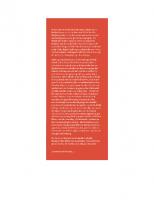The Delhi College: Traditional Elites, the Colonial State, and Education before 1857 [Illustrated] 0195677234, 9780195677232
This volume explores the history of the Delhi college - considered the centre of Delhi Renaissance and the meeting groun
314 124 47MB
English Pages 350 [352] Year 2006
Recommend Papers
![The Delhi College: Traditional Elites, the Colonial State, and Education before 1857 [Illustrated]
0195677234, 9780195677232](https://ebin.pub/img/200x200/the-delhi-college-traditional-elites-the-colonial-state-and-education-before-1857-illustrated-0195677234-9780195677232.jpg)
- Author / Uploaded
- Margrit Pernau (editor)
File loading please wait...
Citation preview
The Delhi College
010111,
by
Google
Ong11"1al frcm
UNIVERSITY OF MICHIGAN
---·---
Dguze •
Gol gle
Orgna from
UNIVERSITY OF MICHIGAN
The Delhi College
01g1t1zed oy
GOt)gle
Original from
UNIVERSITY OF MICHIGAN
019111zea t,
Gol ·gle
Ongir.al trom
UNIVERSITY OF MICHIGAN
The J}elhi College Traditional Elites, the Colonial State, and Education before 1857
Edited by Margrit Pernau
OXFORD VNIVBll.SITY Pll.BSS
Digitized by
Google
Ong1nal from
UNIVERSITY OF MICHIGAN
•
G.. f-1-< ~,;
iei I (.p '1
94
OXFORD
p 4;; t.\
VNIVBllSITY PUSS
o)t, O'v; YMCA.library Building, Jai Singh Road, New Delhi 110 001 Oxford University Press is a department of the University of Oxford. It furthers the University's objective of excellence in researc.h, scholarship, and education by publishing worldwide in Oxford New York Auckland Cape Town Dar es Salaam Hong Kong Karachi Kuala Lumpur Madrid Melbourne Mexico City Nairobi New Delhi Shanghai Taipei Toronto With offices in
Argentina Austria Brazil Chile Czech Republic France Greece Guatemala Hungary Italy Japan Poland Portugal Singapore South Korea Switzerland Thailand Turkey Ukraine Vietnam Oxford is a registered trade mark of Oxford University Press in the UK and in certain other countries Published in India by Oxford University Press, New Delhi
C> Oxford University Press 2006 The moral rights of the author have been asserted Database right Oxford University Press (maker)
First published 2006 All rights reserved. No part of this publication may be reproduced, stored in a retrieval system, or transmitted, in any form or by any means, without the prior permission in writing of Oxford University Press, or as expressly permitted by law, or under terms agreed with the appropriate reprographics rights organization. Enquiries concerning reproduction outside the scope of the above should be sent to the Rights Department, Oxford University Press, at the address above You must not circulate this book in any other bindJng or cover and you must impose this same condition on any acquirer ISBN-13: 978-0-19-567723-2 ISBN-10: 0-19-567723·4 'fypeset in Palatino in 10/12 by Excellent Laser 'fypesetters, Pitampura, Delhi 110 034 Printed in India at Pauls Press, New Delhi, Published by Oxford University Press YMCA Llbrary Building, Jai Singh Road, New i;>elhi 110 001
oig1t1ze-0 by
Google
Original frcm
UNIVERSITY OF MICHIGAN
Preface
I
t is impossible to speak of the Delhi College and not mention the man who has done more over the years than any other person to keep the spirit of its intellectual tradition alive and to convince the authorities to preserve its beautiful buildings from crumbling: Professor Yunus Jaffery. No one who has experienced it will ever forget the unfailing courtesy with which he treated his visitors to tea and the large stores of his knowledge. He would truly have deserved a felicitation volume for his seventy-fifth birthday in 2005, if it were not for one problem: the fields of his interests and scholarship, to which he guided his 'academic family' from all over the world, were just too wide! No one could have convinced a publisher to bring out a volume covering the centuries from the early Muslim rulers of Delhi almost to the present, extending over Persia and the whole of Hindustan, and encompassing not only art and architecture, but history, linguistics, literature, philosophy, and mysticism, I was searching for a solution to this dilemma when it occurred . to me that a book on the Delhi College, on the institution he has lived for and that he cherishes more than his own person, would be the right way not only to acknowledge, but to carry on his lifework. I know that with his characteristic modesty Professor Jaffery would have preferred to remain unnamed and let all the attention fall on the college alone, but this was a wish I for once was not inclined to grant him.
September 2006
Margrit Pernau
Berlin
oig1tlze1lby
Google
Origi~al
rron1
UNIVERSITY OF MICHIGAN
Orlglral from
UNIVERSITY OF MICHIGAN
Contents
Preface
v
List of Illustraticms
lX
Introduction Margrit Pernau
1
Section 1: The Historical Background 1 The Madrasa of Ghaziu' d-Din Khan at Delhi Ebba KDch 2 Transculturation, Assimilation, and its Limits: The Rise and Fall of the Delhi White Mughals 1805--57
35
60
William Dalrymple Section 2: Patrons and Teachers 3 Dr Aloys Sprenger and the Delhi College M. Ikram Chaghatai
105
4 Azurda: Scholar, Poet, and Judge
125
Swapna Liddle 5 Shaikh Imam Bakhsh Sahba'i: Teacher, Scholar, Poet, and Puzzle-master
C.M. Naim
0191t1zed by
Google
Original from
UNIVERSITY OF MICHIGAN
145
I
viii
+
Contents
Section 3: Pupils
6 The Perils of Cultural Mediation: Master Ram Chandra and Academic Journalism at Delhi College
189
Gail Minault
7 Scholar Manque or Mere Munshi? Maulawi Karimu'd-Din's Career in the Anglo-Oriental Education Service
203
Avril A. Powell
8 Mohan Lal Kashmiri (1812-77): An Initial Student of Delhi English College
232
Michael H. Fisher
9 Maulawi Zaka Ullah: 261
Sharif Culture and Colonial Rule
Mushirul Hasan
10 Deputy Nazir Ahmad and the Delhi College
299
Christina Oesterheld Notes on Contributors
325
Index
327
Digitized by
Google
Ong1nal from
UNIVERSITY OF MICHIGAN
Illustrations
1.1
1.2
1.3 1.4 1.5
1.6 1.7 1.8
1.9
View into the courtyard of the madrasa of Ghaziu' d-Din .Khan painted by the Indian artist Sita Ram for Lord Hastings in 1815, inscribed erroneously as 'Shah Jehan's Musgid and Dewan .Khanah to the left'. Add. Or. 4819 (53.0 x 36.5 cm). The artist shows the south wing, part of courtyard with the tank and mosque in the background. By permission of the British Library, London Ground plan of the madrasa of Ghaziu'd-Din .Khan, end of seventeenth or early eighteenth century. Drawing by Richard A. Barraud and Ebba Koch South wing and part of courtyard. Courtesy: Ebba Koch Gate from south~ast. Courtesy: Ebba Koch Ground plan of the mosque of the madrasa of Ghaziu'd-Din .Khan, end of seventeenth or early eighteenth century. Drawing by Richard A. Barraud and Ebba Koch Mosque from east. Courtesy: Ebba Koch Pillar of prayer hall. Courtesy: Ebba Koch Jali screen with naturalistic flowers in central arch of south side of mosque to which is attached tomb enclosure of the founder. Courtesy: Ebba Koch Tomb enclosure of the founder from south~ast, painted by Sita Ram, 1815,
Digitized by
Google
Ong1nal from
UNIVERSITY OF MICHIGAN
42
45 49 51
52 54 55
57
x •
Illu.trations
inscribed 'Another view of the Madrissa and Tombs within its enclosure at Delhi' (41.1 x 52.4 cm), Add. Or. 4818. By permission of the British Library, London
8.1
58
'Moonshee of Mohun Lall in the Kandahar Costume from a sketch by Sir Charles O'yly, Bart', frontisP,iece in Mohan Lal, Journey of a tour through
the Panjab, Afghanistan, Turkestan, Khorasan and part of Persia in the company with Lieut. Burnes and Dr Gerard (Calcutta: Baptist Mission Press, 1834)
01g1tizea by
Google
Origlr.al from
UNIVERSITY OF MICHIGAN
235
Introduction
Entangled Translations 1 The History of the Delhi CoHege Margrit Pemau
ore than many other institutions, the Delhi College still evokes a strong emotive reaction. It has come to symbolize an encounter between British and Indo-Muslim culture through the medium of Urdu. Its heroes were men like Master Ram Chandra, the science teacher and Maulawi Zaka Ullah, the historian and textbook writer, who fearlessly set out to discover new knowledge and thus reinvigorated their own culture, guided and helped by a colonial power which was not yet intent on replacing Oriental languages with English. 1bis belief in the profound compatibility of all cultures and hence in a cultural encounter free from the exercise of power, and the experience of humiliation, which Charles Freer Andrews, the British missionary who turned into a close collaborator and friend of Mahatma Gandhi and Rabindranath Tagore, expressed so movingly,2 may be indispensable as a value
M
1 This article fonns part of my larger research project on 'Multiple Identities: The Muslim Community at Shahjahanabad in the Nineteenth Century', which is supported by the Volkswagen Foundation and the University of Erfurt. 2 C.F. Andrews, 2:llkll W/ah of ~/hi, reprint with introductions by Mushirul Hasan and Margrit Pemau, New Delhi, Oxford University Press, 2003.
0191t1zea by
Google
Origiral frcn1
UNIVERSITY OF MICHIGAN
2 • The Delhi College
.
.
with which to shape the future. The historic Delhi College, however, was a much more contested site than the collective memory will have it. Thus, if the one danger to avoid is an overemphasis on the ' hannony of the dialogue between cultures, the almost exclusive interest historiography has taken in recent time in the colonial construction of knowledge also fails to capture the complex interactions which took place in and around the Delhi College. The attention to the interrelation between knowledge and the exercise of power, to which Edward Said's seminal work3 has directed historians, remains important to this day. Cultural encounter in nineteenth-

![The Delhi Omnibus [Illustrated]
019565983X, 9780195659832](https://ebin.pub/img/200x200/the-delhi-omnibus-illustrated-019565983x-9780195659832.jpg)





![The U.S. Army War College: Military Education in a Democracy [Illustrated]
1566399599, 9781566399593](https://ebin.pub/img/200x200/the-us-army-war-college-military-education-in-a-democracy-illustrated-1566399599-9781566399593.jpg)

